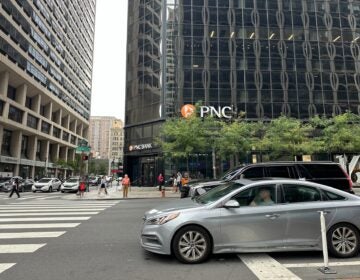Why Philadelphia punted on tax abatement reform … again
Despite resounding calls for changing the tax subsidy, none of the six pending proposals for reform have moved forward.

Philadelphia Councilmember Helen Gym. (Emma Lee/WHYY)
This story originally appeared on PlanPhilly.
—
Councilmember Helen Gym said that when City Council reconvenes this fall, reforming Philadelphia’s 10-year property tax abatement will be her top priority. Mayor Jim Kenney’s administration and City Council President Darrell Clarke also said they anticipate robust debate about the issue.
Suggestions for reform range from total elimination of the subsidy to a proposal that would marginally reduce its value. Will any of these actually happen? Unclear.
It’s been over 13 months since Gym first introduced bills to reform the abatement — sparking a wave of other suggestions for changing the subsidy. Its fate became one of the touchstone issues in the May municipal elections, with almost all candidates arguing it needed to be changed.
But when Council’s spring session concluded last month, none of the six pending abatement reform bills had received so much as a hearing.
Asked why not, Gym refused to place blame on specific actors.
“Obviously, I believe they should have been heard and it’s time for them to be heard,” she told PlanPhilly. “This summer going into the fall we need a lot more public discussion.”
Building consensus is also the excuse given by the Kenney administration for why action has not yet been taken.
“Councilmembers have been meeting with stakeholders on abatement reform as well as with members in the Kenney administration,” wrote Patricia Gillett, a spokesperson for Clarke, in an email message. “The Council President’s Office anticipates that there will be a legislative package that includes abatement reform on Council’s fall agenda.”
Established in the late 1990s, the abatement allows owners to avoid property taxes for 10 years on new construction or the value of renovation. For decades, it’s been a sacrosanct stimulant to construction in the city, defended by two of the most influential local interest groups — the real estate industry and building trades unions.
“[In the 1990s], the city was losing a lot of population and there was a downturn in housing starts,” said Larry Ceisler, a longtime City Hall lobbyist and consultant. “The construction trades wanted to be paid to scale and the developers couldn’t make the numbers work in that economy. So one of the reasons it was put in place was to help developers pay to scale for union projects.”
The conversation around the abatement began to change during City Council’s debate over affordable housing in 2018, when advocates began asking why the city was giving away such a lucrative tax incentive for so little in return.
Abatement skeptical voices on City Council like Gym and Maria Quiñones-Sánchez were emboldened, and powerful actors like Clarke and union leader John Dougherty began to express support for reform.
It still remains unclear what tax abatement reform will look like.
Options range from Coucilmember Cindy Bass’s call to totally eliminate the subsidy — which is unlikely to go anywhere — to a proposal introduced by Councilmember and real estate mogul Allan Domb, which would basically reduce it to an eight-and-a-half year abatement. Gym’s bills would eliminate the abatement on 55% of every tax dollar that goes to the school district, cap the eligibility for subsidy to exclude higher-end projects, and phase it out over a 10 year period (reducing the exemption by 10% each year). She also introduced a bill to study the effects of limiting the abatement geographically to exclude rapidly growing areas like Center City.
Even builders support reform
During a Center City District-hosted discussion at the Union League last week, representatives from labor, industry, and Council debated the abatement’s future.
Gym said that in addition to the cap, she would like to see a phase out that sends funds directly to the school district. Domb said that he wants to see commercial development unaffected, to ensure that office towers are incentivized for their job creation potential. (Commercial development lags behind the residential sector in Philadelphia.)
Leo Addimando of the Building Industry Association said he supports reform (the BIA does not have an official position). But he denounced the idea of capping the abatement, arguing that a cap would discourage the wealthy from moving back to the city and keep their tax dollars sequestered in the suburbs.
“I know the politics of saying you can have it only up to $400,000 plays well and you can get support behind it,” the influential builder and industry advocate told the room of Center City District members. “But [without it], they won’t move to the city, developers won’t build product to attract them, and all the tax benefits they provide to the city will go away.”
Addimando said he personally believes the abatement should be kept intact outside hot markets in and around Center City, while in Philadelphia’s core the subsidies should be gradually reduced over the program’s 10 year span.
Addimando argued that many major high-end projects — think Carl Dranoff’s new building on South Broad Street, The Laurel on Rittenhouse Square, or One Riverside along the Schuylkill River — would not go forward if the abatement was scuttled. The construction jobs and tax dollars they bring to the city (including, eventually, property tax dollars) are worth the bad political optics, he said.
Councilmember Gym, who was also on the panel at the Union League, did not agree.
“I think the capping of the abatement is a more refined policy that still encourages growth and development,” said Gym after the panel concluded. “I have yet to hear a good argument about why abatements for millionaires needs to be the thing that Philadelphia prioritizes.”
WHYY is your source for fact-based, in-depth journalism and information. As a nonprofit organization, we rely on financial support from readers like you. Please give today.







